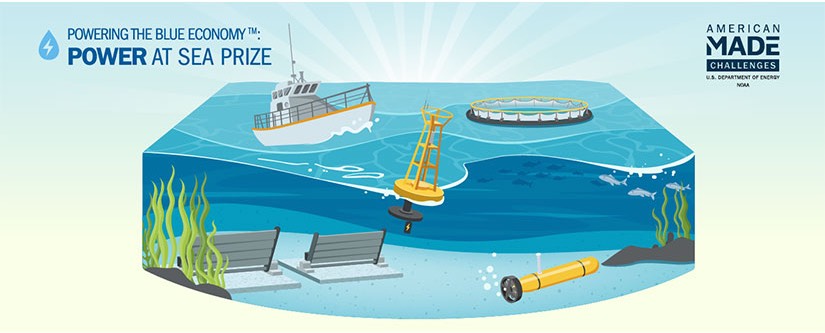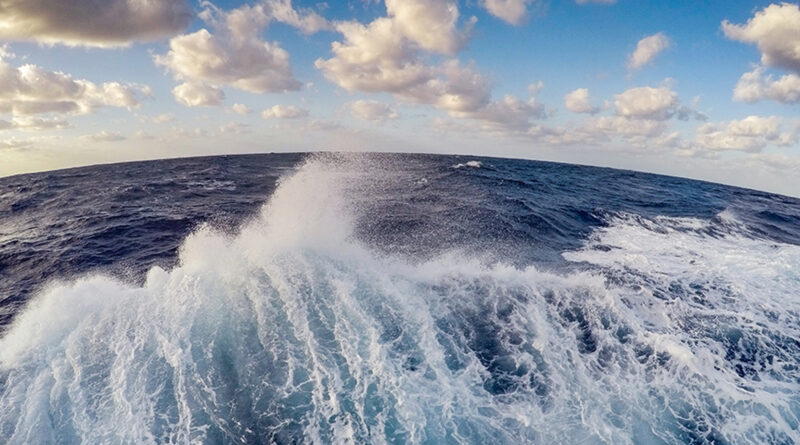Accelerating Power At Sea For A Thriving Blue Economy
New Prize Challenges Competitors To Seek Innovative Solutions To Help Ensure Energy Endurance in Ocean Extremes

The ocean contains enough water to fill quintillions of gallon-sized containers. It is no surprise then that these vast waters hide mysteries, many of which remain beyond humanity’s reach. But some mysteries—like brewing superstorms and tsunamis or rapidly declining seafood—are too important to ignore. Disaster warnings can save lives; seafood sustains them.
But it is not just the ocean’s size that stymies exploration. Ocean exploration requires technology, technology needs energy, and the ocean is a power desert. But it does not have to be.
Cue the Powering the Blue Economy™: Power at Sea Prize. Last week, the U.S. Department of Energy’s Water Power Technologies Office (WPTO) launched this new, $1.7 million challenge. The prize is part of the American-Made Challenges program and administered by the National Renewable Energy Laboratory and Pacific Northwest National Laboratory.
Through the Power at Sea Prize, teams will compete to advance offshore technologies that can harness some of the ocean’s immense energy (also known as marine energy, or energy generated from waves, currents, tides, or even changes in salinity, pressure, or temperature). Through two prize phases, teams will explore how to build technologies that could support offshore activities—such as marine research or seafood farming—while protecting the ocean’s vast resources (a concept known as Powering the Blue Economy).
There is enough wave energy in U.S. waters to provide almost 60% of the country’s electricity needs. Although the United States cannot harness all that energy, even just a small portion could help power budding ocean exploration technologies. These devices could, for example, power efforts to monitor fish and wildlife populations and ecosystem health, more accurately predict when and where tropical storms might arise, or clarify the ocean’s role in managing climate change. But before the ocean can power all that knowledge collection, researchers, entrepreneurs, and other innovators must turn their early-stage concepts into technologies.
The sooner the better: Global communities are turning to the ocean more and more for everything from food to data to transportation. Of course, all that activity needs energy. Through the Powering the Blue Economy Initiative, WPTO aims to energize this so-called blue economy while also protecting and preserving the ocean’s valuable resources. The new Power at Sea Prize aligns with that mission.
Over the prize’s two phases, competitors will work to develop novel marine energy technology designs (concepts can be in the early stages of development). During the first phase, CONCEPT, each team will start to hone its design and must choose one blue economy challenge to address. For example, teams could focus their technologies to:
- Increase access to offshore work by decreasing the cost to power these activities or increasing opportunities to service and maintain offshore technologies
- Improve deployment duration or how long a device can remain at sea
- Enhance energy storage, so offshore technologies can do more, like collect more data or survey more ocean area, before draining their batteries or returning to shore
- Minimize negative environmental or ecological impacts on local flora and fauna
- Overcome harsh operational conditions by addressing challenges, like unwanted growth of marine organisms
- Harness marine energy to hybridize with other renewable energy resources and fill power gaps caused by variable energy resources, like solar power and wind energy
- Generate suitable power to meet the needs of various offshore technologies, like sensors, instrumentation, and automation, to maximize a device’s efficiency.
At the end of the first phase, prize administrators will select up to 20 winning teams to receive a cash prize from a pool of up to $200,000. In the second phase, DEVELOP, competitors will refine their designs and receive support, so they can continue to develop the technology after the prize concludes. Up to 20 DEVELOP phase winners will earn cash prizes from a pool of up to $1,500,000. Teams will also receive technical support through office hours, webinars, networking sessions, and trainings on marine energy, blue economy applications, commercialization best practices, or other topics of interest.
The National Oceanic and Atmospheric Administration (NOAA) Fisheries Office of Aquaculture, NOAA-led U.S. Integrated Ocean Observing System, NOAA Ocean Acidification Program, and NOAA’s National Sea Grant College Program also provide technical support for this prize.
The Power at Sea CONCEPT phase is now open for submissions and will close on July 26, 2024. Learn more about the challenge in its first webinar, to be held on Nov. 29, 2023.
Visit American-Made Challenges to find even more U.S. Department of Energy competitions designed to spur innovation in clean energy. Learn more about NREL’s marine energy research and development, and subscribe to the laboratory’s water power newsletter.
By Samantha Cuneo. Article courtesy of NREL.
Have a tip for CleanTechnica? Want to advertise? Want to suggest a guest for our CleanTech Talk podcast? Contact us here.
Latest CleanTechnica.TV Video

CleanTechnica uses affiliate links. See our policy here.

